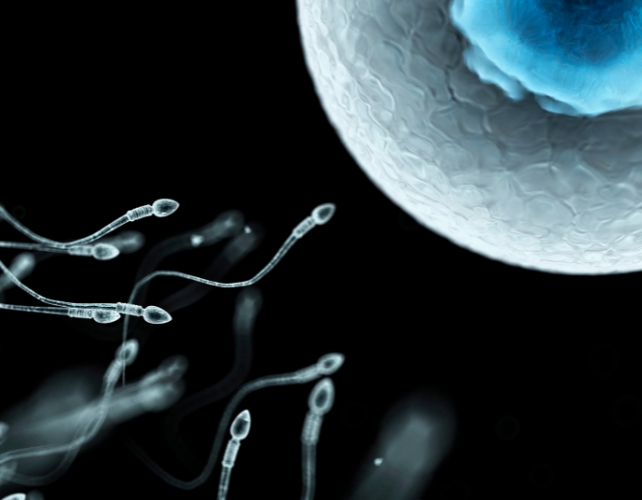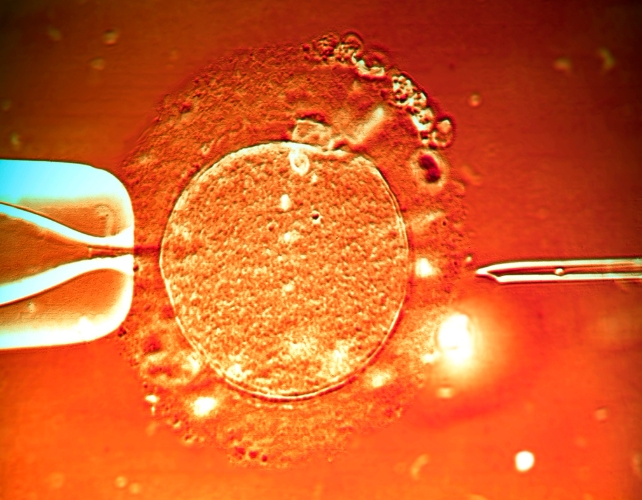ARTICLE AD
Unless you skipped sex ed class, you probably have at least a basic understanding of how babies are made. An egg (ovum) needs to be fertilised by sperm during a precise window in the menstrual cycle for life to happen.
Sexual intercourse provides optimal conditions for reproduction. But that doesn't mean that every pregnancy happens this way.
There are also examples of women conceiving in extremely rare circumstances that you'd expect to be impossible.
1. Via anal sex
While cases of pregnancies resulting from anal sex are incredibly rare, they do happen. But they've only ever occurred in people with a reproductive abnormality called a cloacal malformation.
This abnormality occurs in one in every 50,000 girls and will require corrective surgery and even with this there is a high probability of leading to complications such as renal failure, incontinence, difficulty getting pregnant and greater risk of early labour.
A cloaca is a "common hole" for urination, defecation and reproduction. It's typically seen in reptiles and birds and even platypuses.
In humans, tissue grows down and divides the cloaca into two or three openings – depending on the sex. But in rare cases, this tissue fails to completely split the rectum from the vaginal cavity.
When this happens, it may allow sperm to swim through any opening in the dividing tissue wall towards the egg to fertilise it. The fertilised egg will normally implant into the womb, as usual.
If you're wondering why the sperm don't just continue swimming up the rectum, that's because they work by chemotaxis. This means they're able to detect trace amounts of chemicals that the ovum produces.
As the sperm swim towards the ovum, the amount of these "chemoattractants" they detect increases, signalling them to continue travelling in the right direction.
 Egg and sperm. (sciencephoto/Canva Pro)
Egg and sperm. (sciencephoto/Canva Pro)2. Via oral sex (and one very heated argument)
Sperm's dogged ability to navigate towards the egg is perhaps demonstrated no better than in one of the more bizarre case reports recorded in the medical literature.
A young girl born without a vagina came to doctors complaining of intermittent abdominal pain – which, in many ways, mimicked contractions.
Further investigations by doctors revealed a foetus within her uterus – and that the woman's pain was happening because she was in labour. The baby was immediately delivered via c-section.
Given the girl was born without a vagina, this ruled out intercourse as the method of conception. But precisely 278 days before, the girl had been admitted to hospital with stab wounds in her stomach. The wounds were the result of a knife fight between her, her jealous ex and her new partner.
It transpired that just before the knife fight had occurred, she had performed oral sex on her new partner.
So when the surgery was done to repair her stomach wounds, it potentially washed any sperm that still existed around her abdominal cavity – allowing them to migrate towards and fertilise the ovum.
Sperm in the peritoneal cavity (the space between your abdominal organs and body wall) is not unheard of.
This cavity contains a special fluid that helps your organs move around when food is passing through. And research has shown this fluid can also support the survival of sperm, enabling it to travel through this cavity to the ovum.
3. Splash pregnancies
"Splash pregnancy" is another way that a person may become pregnant without having had intercourse.
As the name suggests, if semen splashes against the external genitalia, sperm may find their way into the vagina and swim towards the ovaries.
Splash pregnancies are highly unlikely. This is because sperm don't survive for more than half an hour outside the body. While healthy sperm swim at up to 5mm a minute, they only survive for a limited period of time (up to five days in women's genitalia).
Of the hundreds of millions of sperm that are ejaculated into the vagina during intercourse, where conditions are ideal, only 200-300 will make it to the egg. You can see why a splash pregnancy is so rare.
A splash pregnancy cannot occur from sperm in bathwater or hot-tubs. This is because the water disperses the sperm and dilutes the seminal fluid that usually protects sperm from the woman's harsh internal genitalia and the outside world. Chemicals such as chlorine in the water also rapidly kill sperm.
 Light micrograph of injection of human sperm into a human egg cell. (Science Photo Library/Canva Pro)
Light micrograph of injection of human sperm into a human egg cell. (Science Photo Library/Canva Pro)4. Double pregnancy
The body has a mechanism that prevents subsequent pregnancies from happening while a woman is already pregnant. This is true even for women who are born with two uteri, as these mechanisms work hard to prevent a second pregnancy happening.
Hormones prevent ovulation and produce a thick mucus plug that covers the cervix to prevent sperm travelling into the uterus towards the ovary.
But one event, called superfetation, throws those rules out the window. This process sees a second pregnancy manifest while the first is already progressing.
This phenomenon is so rare that scientists don't fully understand how it happens. Most recorded cases have been in women who used IVF.
The two pregnancies often happen very close to each other, usually within two to four weeks of one another. This means that the babies can be delivered at the same time, as twins.
Although there's a gestational age gap, most of these pregnancies progress normally without complications beyond what is seen more broadly.
These examples are of course extremely rare – so you probably don't need to worry too much. But if you aren't looking to get pregnant anytime soon, be sure to use contraception.![]()
Adam Taylor, Professor and Director of the Clinical Anatomy Learning Centre, Lancaster University
This article is republished from The Conversation under a Creative Commons license. Read the original article.

 4 months ago
28
4 months ago
28 

